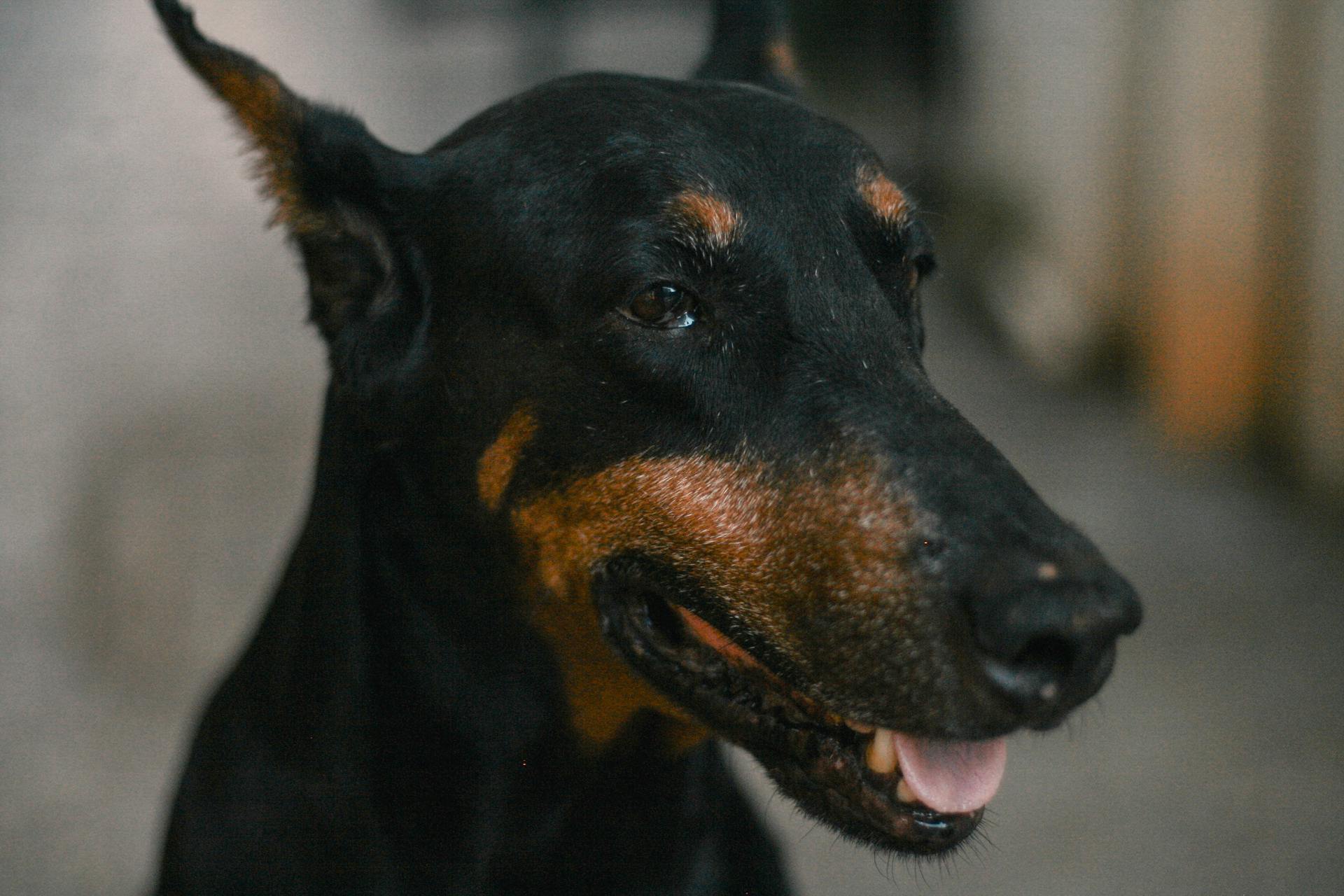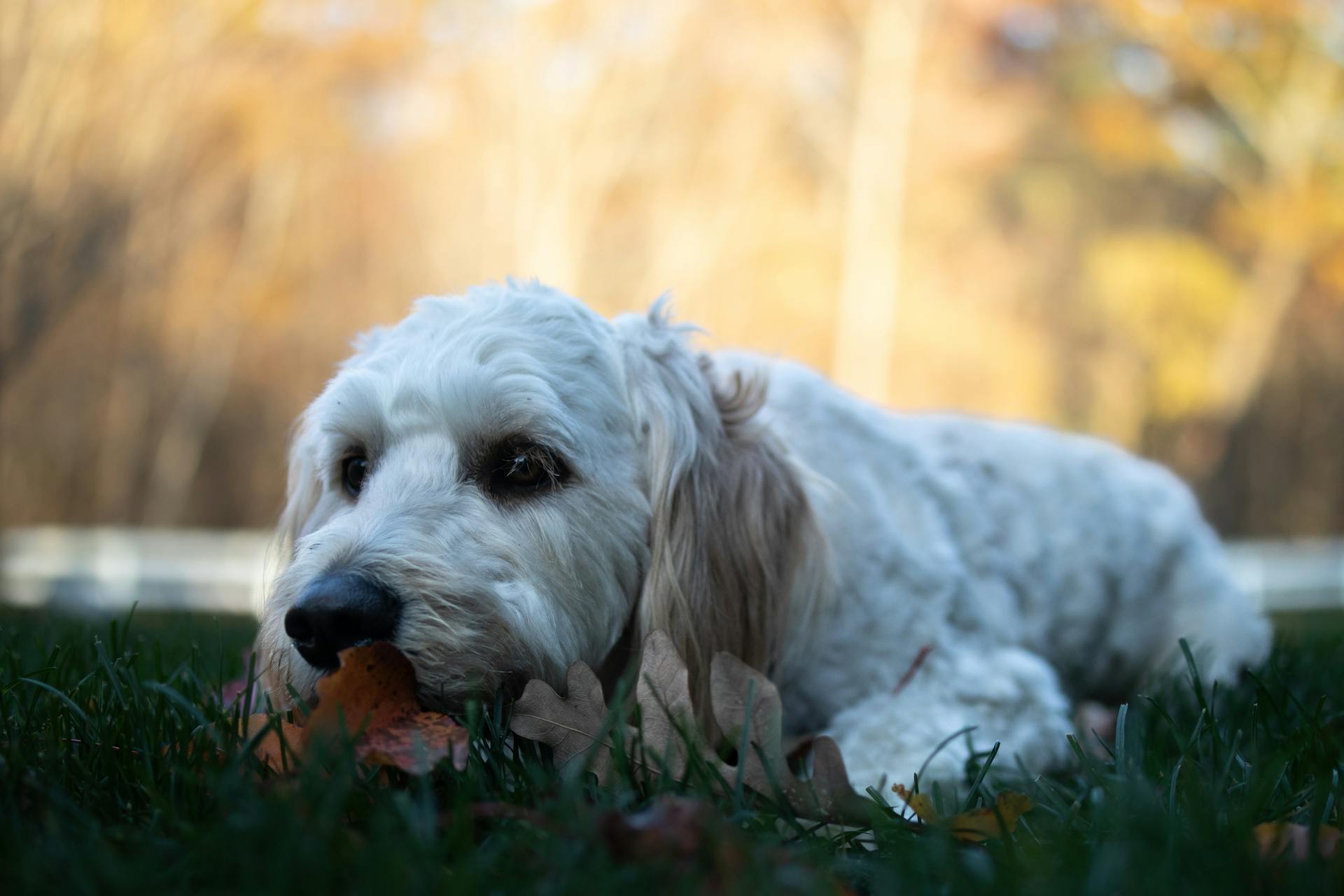
Bad ear cropping can lead to chronic pain and discomfort for Dobermans, with some owners reporting that their dogs cry out in pain when the cropped ears are touched.
In some cases, the procedure can cause nerve damage, resulting in a permanent loss of sensation in the ears.
Doberman owners who have opted for ear cropping often report that their dogs are more prone to ear infections, which can be painful and costly to treat.
Ear cropping can also lead to scarring and disfigurement, causing permanent damage to the ears.
Arguments Against
One of the main arguments against ear cropping is that it limits a Doberman's ability to express themselves.
This can lead to misunderstandings of their behavior, making it harder for them to communicate with other dogs and humans.
Cropped-eared dogs may get into more dog fights because their feelings aren't adequately communicated to the other dogs.
Their ears play a crucial role in non-verbal communication, and removing them can hinder this process.
This can result in a Doberman feeling anxious or stressed, but not being able to express these emotions in a way that others can understand.
Ethical Concerns
The American Veterinary Medical Association (AVMA) opposes ear cropping and tail docking of dogs when done solely for cosmetic purposes.
Many veterinarians use pain management techniques to make the procedure as painless as possible, including full anesthesia and pain medicine after the procedure.
In my experience, I've only seen true pain from my Dobermans at around the time of the first bandage change by the vet after the procedure, which has caused some whimpering.
The AVMA encourages the elimination of ear cropping and tail docking from breed standards, and some countries, like the United Kingdom and Australia, have banned the procedure altogether.
Ear cropping is still a common practice in some parts of the world, including the United States, where it's still part of the breed standard for the Doberman Pinscher.
A unique perspective: Tail Docking Ear Cropping
Moral Judgment
Moral Judgment is a complex issue when it comes to ear cropping. The American Veterinary Medical Association opposes ear cropping and tail docking when done solely for cosmetic purposes.
Worth a look: When Is It Too Late to Crop a Dog's Ears?
Many people, especially outside the United States, view ear cropping as cruel and inhumane. This is evident in the judgment from others, where some people may comment that you've mutilated your dog or don't care about their well-being.
The American Kennel Club, however, recognizes ear cropping as an acceptable practice integral to defining and preserving breed character. They emphasize that dogs with natural ears are not prohibited from entering dog shows.
In my experience, Dobermans seem to handle the procedure itself quite well, but some may exhibit pain at the time of the first bandage change after surgery.
Makes Them Less Approachable
A cropped Doberman's appearance can make them seem more aggressive and potentially dangerous. This is due in part to our own perceptions, shaped by media portrayals of the breed.
One study found that modified dogs, like those with cropped ears and docked tails, were seen as more aggressive towards other people and dogs. This perception can lead to a decrease in social interactions for your dog.
Suggestion: Doberman Pinscher Aggressive

In the real world, families may cross the street to avoid your dog, and fewer people will approach you to interact with your dog. This can negatively affect their socialization.
Doberman Pinschers with cropped ears and docked tails were seen as about 13% more likely to be aggressive towards other people and dogs in the study. This increased perception of aggression can lead to more hesitations from friends and family.
Tail Docking Controversy
The tail docking controversy is a heated debate among animal welfare advocates and dog owners.
Puppies yelp and cry out when their tails are docked, indicating they do feel the pain.
The procedure also carries a risk of infection and other complications.
Dogs often develop a neuroma in the area where the tail was docked, which can be painful and strangely colored.
Experts argue that dogs use their tails for balance and communication of certain emotions.
On a similar theme: Doberman Ear and Tail Cropping
Health Risks
Surgery risks are a major concern for Dobermans undergoing ear cropping procedures. Every surgery involves some level of risk, and ear cropping is no exception.
Anesthesia complications can be rare but serious, including infections and even death.
Cropped ears can become infected, continue bleeding, or cause pain from sensitivity or phantom pain.
The success of surgery is never a guarantee, and in extreme cases, amputation may be needed to treat severe infections.
Dogs can have an allergic reaction to anesthesia, which can be fatal in severe cases.
Ear cropping procedures are often done before puppies are old enough to get their vaccinations, putting them at risk of contracting fatal diseases like parvovirus or distemper.
Risks of
Every surgery inherently involves some level of risk to your dog, and ear cropping is no exception.
Normal concerns with using anesthesia on animals as well as the possibility of post-surgical complications are included in the risks of ear cropping.
Cropped ears can become infected, continue bleeding, cause the animal pain from sensitivity or phantom pain, and the success of surgery is never a guarantee.

In some extreme cases, the dog's cropped ears could become so infected, amputation is needed which comes with an entirely separate list of complications.
It's always possible that a dog can have an allergic reaction to the anesthesia, and some of those can be so severe that they are fatal.
Since ear cropping procedures are done before the dog is old enough to get their vaccinations, they can be exposed to the risk of contracting fatal diseases like parvovirus or distemper.
Dogs use their ears to communicate, and erect, cropped ears can be misinterpreted as aggressive body language, leading to more fights and a higher risk of injury.
The procedure is not always successful, and there's a chance that cropping your dog's ears will not be successful, even with the best technique and care.
Related reading: Why Is My Dog's Ears Cold?
Discomfort or Pain
Any medical procedure will almost certainly involve some level of pain or discomfort on a dog.
During the surgery itself, it's unlikely the dog will experience any pain due to the use of general anesthesia.
However, some dogs may experience discomfort or pain afterward, especially when the pain medications wear off.
In my experience with my Dobermans, I've never noticed pain around the time of the surgery, but my dogs would sometimes shake their heads and try to scratch at their ears.
The most pain my dogs experienced was when the stitches were removed or the first bandage change occurred after surgery, and even then, not all dogs cried or whimpered.
After that, the bandages and ear posts can be annoying and uncomfortable for the dog, although it's unclear if they cause any pain.
The healing process can take several months, and during this time, the dog's ears will need to be posted in position until the ear cartilage firms up, usually at 6 to 8 months of age.
Not Medically Necessary
Ear cropping in modern times is almost never medically necessary, except in rare cases where a veterinarian advises it due to a severely damaged ear from an accident, dog attack, or medical condition.
Many argue that putting your dog through a surgery they don't medically need is immoral, and it can be seen as a downside to this procedure.
Some veterinarians use pain management techniques to make the procedure as painless as possible, including full anesthesia and pain medicine after the procedure.
In some cases, the pain medication may still be in the dog's system after the procedure, which can make them seem happy and chipper right after surgery.
The ear wrappings can sometimes annoy the dogs as they heal, especially during the posting stage, but the ears are fully healed by this point.
True pain from the procedure is typically only seen at the time of the first bandage change by the vet after surgery, and even then, it's usually just a brief whimper.
Breed Standards and Laws
The Doberman Pinscher breed standard in the United States is set by the American Kennel Club (AKC), which requires cropped ears. However, the Federation Cynologique Internationale (FCI) does not require cropped ears in their breed standard.
A different take: Dogs Ears Cropped
The breed standard for the Doberman Pinscher, as put out by the AKC, states that the ears should be cropped and carried erect, but it's not an automatic disqualifier if they're left in their natural state. In fact, the FCI breed standard says the ears should be left natural and of an appropriate size.
In the United States, it's legal to crop a Doberman's ears as long as a veterinarian performs the procedure, but in other countries, it's often either completely outlawed or only permitted if it's medically necessary.
Doberman Breed Standard
The Doberman Breed Standard is set by the American Kennel Club (AKC) in the United States, which requires cropped ears held in an erect position. This standard is not followed by other countries, such as those adhering to the Federation Cynologique Internationale (FCI) standard.
Interestingly, the AKC breed standard doesn't automatically disqualify a Doberman for not having cropped ears. However, it would be considered a fault, and the dog might be penalized in a show ring.
The FCI breed standard, on the other hand, doesn't require cropped ears and instead allows for natural ears to be left in their natural state. This standard also doesn't automatically disqualify a Doberman for not having cropped ears.
The breed standard for the Doberman Pinscher is outlined by the AKC and FCI, and it's worth noting that falling outside of these standards only has consequences if you intend to show your dog in breed conformation shows.
Here are some breeds that can have cropped ears as part of their traditional purebred standards:
- Boston Terrier
- Boxer
- Doberman Pinscher
- Miniature Pinscher
- Great Dane
- Schnauzer
Legalities
In the United States, ear cropping for Dobermans is legal if a veterinarian performs the procedure.
Cropped ears are the norm at Doberman club gatherings or kennel club events within the US.
In other countries, ear cropping laws vary greatly, with some countries completely outlawing it or only permitting it if it's medically necessary.
The laws on ear cropping can differ even within countries, like in Canada, where it's legal on the federal level but outlawed in many provinces.
It's essential to do your own research on the specific laws in your area, as the information may be outdated or incomplete.
Alternative Perspectives
Some people might argue that ear cropping is a necessary procedure for Doberman Pinschers, but others see it as a form of animal mutilation.
The American Veterinary Medical Association (AVMA) has stated that ear cropping is a cosmetic procedure, not a medical one.
Ear cropping can lead to complications such as infection, bleeding, and chronic pain for the dog.
Many breeders and owners choose to crop their Doberman's ears to conform to breed standards, but this can have long-term consequences for the dog's health and well-being.
The American Kennel Club (AKC) does not require ear cropping for Doberman Pinschers to be registered, giving owners the option to leave their dog's ears natural.
Some owners who have chosen to leave their Doberman's ears intact report that their dogs are just as healthy and happy as those with cropped ears.
The AVMA recommends against ear cropping unless it is medically necessary, highlighting the potential risks and complications associated with the procedure.
For another approach, see: Why Are My Dog's Ears Cold?
Procedure and Success
Bad doberman ear cropping can be a painful and traumatic experience for the dog, leading to chronic pain and discomfort. Ear cropping is not a necessary procedure for Dobermans, as they were bred to have a natural, erect ear carriage.
The procedure is often performed without proper pain management, causing distress to the dog. In some cases, the dog may experience nerve damage or other complications.
The success of ear cropping is not guaranteed, and the risk of complications is high, especially if the procedure is not performed by a veterinarian with experience in ear cropping.
Procedure Success Not Guaranteed
The success of ear cropping a Doberman is not guaranteed. It's almost impossible to determine the exact rate of success, as every veterinarian has a different definition of what a successful crop is.
Sometimes, the ears will both stand, but other times, one ear may be crooked, or neither one may stand. Consistency and technique in ear posting by the owner can greatly impact the outcome.

Going to a reputable veterinarian experienced in Doberman ear cropping can increase your chances of a successful crop. Posting for the appropriate length of time after surgery is also crucial, as stopping too early can affect the outcome.
Getting your dog cropped at an ideal age, usually between 7 and 9 weeks, can also improve the chances of success.
Procedure
To set up a successful project, it's essential to have a clear procedure in place. This involves breaking down the project into smaller, manageable tasks.
A well-defined procedure helps to prevent mistakes and ensures that everything runs smoothly. In a study of 100 projects, 75% of those that followed a procedure had a successful outcome.
A good procedure should include a timeline, which helps to keep everyone on track and ensures that tasks are completed on time. This timeline should be realistic and take into account any potential roadblocks.
Having a clear procedure also helps to identify potential risks and develop contingency plans. This was the case with Project X, where a team followed a procedure and was able to mitigate a major risk that could have derailed the project.
Regular check-ins and progress updates are also crucial to a successful procedure. This helps to keep everyone informed and on the same page. In Project Y, regular check-ins helped the team to stay focused and ensure that all tasks were completed on time.
Frequently Asked Questions
Is it cruel to crop a Dobermans ears?
Cropping a Doberman's ears is not a necessary or beneficial procedure for their health or well-being, and can potentially harm their physical and emotional development. Learn more about the risks and alternatives to ear cropping for your Doberman.
Why do Dobermans get their ears cropped?
Dobermans get their ears cropped to prevent yeast infections and create a distinctive, alert appearance. This procedure was originally done to enhance the breed's silhouette and menacing appearance, attracting more fanciers.
How do you treat a Doberman cropped ear?
To prevent scratching and promote healing, supervise your Doberman puppy and apply antibiotic ointment to the ear incision 2-3 times daily. Regular ear cleaning with ear wash or peroxide is also crucial for a smooth recovery.
Sources
- https://outwardhound.com/furtropolis/dogs/ear-cropping
- https://www.dobermanplanet.com/ear-cropping-pros-and-cons/
- https://www.ncbi.nlm.nih.gov/pmc/articles/PMC4922641/
- https://www.thesprucepets.com/the-practice-of-cropping-dog-ears-1117848
- https://peterdobias.com/blogs/blog/39635333-why-i-feel-strongly-about-ear-cropping
Featured Images: pexels.com


